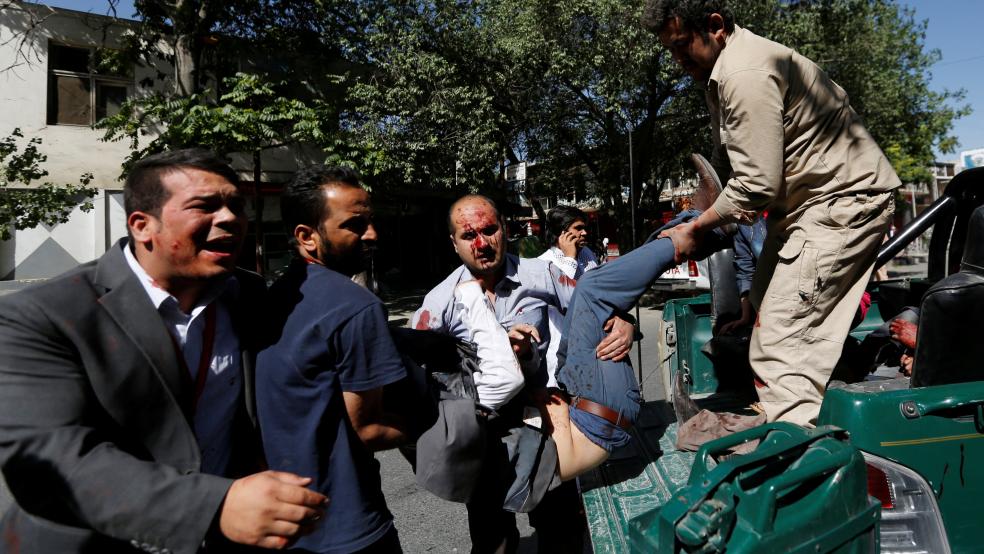Over the last thirteen years, the U.S. has pumped more than $104 billion into building bridges, roads, schools, and hospitals in Afghanistan. The Pentagon has also trained and equipped the country’s military so it would be able to defend itself without relying on U.S. and allied forces.
Now, more than a decade later, with the American drawdown in sight, Afghanistan is still largely reliant on foreign assistance raising serious questions over whether the country will ever really be self-sustainable --despite the hundreds of billions of dollars flowing from the U.S. Treasury.
Related: With Eyes on ISIS, America’s $104B in Afghanistan is Failing
No one has been more critical of the U.S.’s reconstruction efforts Special Inspector General for Afghanistan Reconstruction (SIGAR) John Sopko who’s been charged with the sizable task of monitoring the mission’s ballooning price tag, which has already cost more than World War II’s Marshall Plan.
Last year, Sopko ripped into policymakers for not addressing the widespread corruption in Afghanistan that left unaddressed could undermine the U.S.’s entire decade-long reconstruction effort. He told students at Georgetown University in September that the lack of an anti-corruption strategy was “astonishing, given that Afghanistan is one of the most corrupt countries in the world.”
Since then, Sopko says that Afghanistan may have turned a corner. He praises Afghanistan’s new leadership for working with the U.S. to combat corruption. Sopko says, “I’m the most optimistic I’ve been in the last three years,” because unlike former President Hamid Karzai, newly elected Afghan President Ashraf Ghani and Chief Executive Officer Adbullah have made it a priority to address graft.
Related: U.S. Still Giving a Corrupt Afghanistan a Blank Check
Of course, that isn’t saying much. Sopko’s forecast of Afghanistan has been gloomy ever since he first took the helm at SIGAR in 2012. Late last year, he released a laundry list of items that threatened to derail the entire mission.
“I’m not going to say we won, these are hard battles,” he said. “But …we got a really good partner saying the right thing and doing the right thing.”
Though the reconstruction efforts face a number of hurdles including corruption, sustainability, and Afghanistan’s opium problem, Sopko says the number one issue is whether or not the Afghan National Security Forces are ready to stand on their own.
“The biggest problem is the security issue,” Sopko said. “We’re just getting into the fighting season; we hope and pray that they can handle the security situation. It’s going to be very dangerous, very bloody…we are hoping for the best.”
Related: $65 Billion Effort to Train Afghan Army is Failing
Earlier this year, SIGAR released a damning assessment of the ANSF saying that after the Pentagon spent a decade pumping more than $65 billion into recruiting, training and arming them, the Afghan troops were at their lowest, weakest levels in years.
SIGAR said the ANSF had 20,000 fewer troops than last year, based on numbers provided by the Afghan defense ministry.
The auditors’ findings called into question the Defense Department’s entire approach to building up Afghanistan’s army. It also cast serious doubts on whether the ANSF would be able to stand up on its own when U.S. troops return home.
“The evidence strongly suggests that Afghanistan lacks the capacity—financial, technical, managerial, or otherwise to maintain, support, and execute much of what has been built or established during more than 13 years of international assistance,” Sopko said in a statement after the report was released.
“SIGAR is worried that the Afghan ministries aren’t, in any way, ready to stand on their own,” Sopko said.
Related: What’s the Pentagon Hiding from Its Auditors
On top of that, the IG questioned the accuracy of the information that the Afghan Ministry provided on the ANSF—saying there was really no way to determine whether it was correct, making it impossible to measure the capabilities of the forces
“That’s the 800 pound gorilla in the room. We don’t know the capability of ANSF or if there numbers are real…that’s a big issue,” Sopko said. That makes it even more difficult to determine how much funding is needed, he added.
Still, the U.S. plans to pump an additional $7.6 billion into Afghanistan’s security institutions in the short term, “and billions more are expected to be appropriated every year for the foreseeable future,” he added.
It’s not just security that threatens to derail the effort.
Earlier this year, Sopko sent a letter to the Pentagon, expressing concern that Afghanistan would not be able to meet its budgetary obligations because its domestic revenue had plummeted, mainly because much of it had been stolen. Since revenues were so low, the U.S. provided $100 million to keep the government running. SIGAR has since warned that the U.S. might need to swoop in to help again next year.
The additional funding provided by the U.S. is just a glimpse at how very dependent Afghanistan remains on foreign assistance. And as Sopko says, just because the troops are drawing down soon, doesn’t mean that the money is going to stop flowing.
“The number of soldiers may be coming down, but the important thing to remember is the amount of money going down in Afghanistan is not,” Sopko said. “They still need us to help on support they’re doing the fighting and we’re paying the bills.”
However, the withdrawal of troops in 2016 could pose issues for the team’s oversight efforts, according to a former SIGAR official who explained that the drawdown could complicate things for the watchdogs, who are already restricted in where they can go in Afghanistan to investigate programs and projects that they are required to review.
“Every time I go there, I can see less and less of the country. I like to go kick the tires, see the bridge, see the clinic, and meet the soldiers. But we don’t always get to do that anymore,” he said.
“I have a fear that we don’t realize as a country that doing reconstruction diplomacy is risky business. My fear is that we are too concerned about an American getting hurt or killed…. That is the reality we face we have to realize that if we want to do the work we have to do in Afghanistan, it is not risk free,” Sopko said. “Too many people will want us to cut and run…we can’t do that.”
Top Reads from The Fiscal Times:





